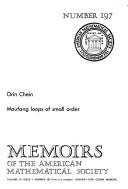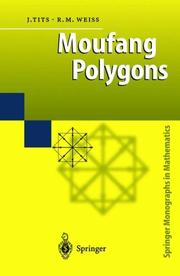| Listing 1 - 10 of 10 |
Sort by
|
Book
ISBN: 1470453215 Year: 2019 Publisher: Providence, RI : American Mathematical Society,
Abstract | Keywords | Export | Availability | Bookmark
 Loading...
Loading...Choose an application
- Reference Manager
- EndNote
- RefWorks (Direct export to RefWorks)
"In 1925, Elie Cartan introduced the principal of triality specifically for the Lie groups of type D4, and in 1935 Ruth Moufang initiated the study of Moufang loops. The observation of the title was made by Stephen Doro in 1978 who was in turn motivated by work of George Glauberman from 1968. Here we make the statement precise in a categorical context. In fact the most obvious categories of Moufang loops and groups with triality are not equivalent, hence the need for the word "essentially.""--
Book
ISBN: 9781470451011 1470451018 Year: 2022 Publisher: Providence, RI : American Mathematical Society,
Abstract | Keywords | Export | Availability | Bookmark
 Loading...
Loading...Choose an application
- Reference Manager
- EndNote
- RefWorks (Direct export to RefWorks)

ISBN: 0821821970 Year: 1978 Publisher: Providence, R.I.
Abstract | Keywords | Export | Availability | Bookmark
 Loading...
Loading...Choose an application
- Reference Manager
- EndNote
- RefWorks (Direct export to RefWorks)
Group theory --- Moufang loops --- Loops, Moufang --- Loops (Group theory) --- Moufang loops.
Book
ISBN: 1470452456 Year: 2019 Publisher: Providence, Rhode Island : American Mathematical Society,
Abstract | Keywords | Export | Availability | Bookmark
 Loading...
Loading...Choose an application
- Reference Manager
- EndNote
- RefWorks (Direct export to RefWorks)
"A Moufang set is essentially a doubly transitive permutation group such that each point stabilizer contains a normal subgroup which is regular on the remaining vertices; these regular normal subgroups are called the root groups, and they are assumed to be conjugate and to generate the whole group. It has been known for some time that every Jordan division algebra gives rise to a Moufang set with abelian root groups. We extend this result by showing that every structurable division algebra gives rise to a Moufang set, and conversely, we show that every Moufang set arising from a simple linear algebraic group of relative rank one over an arbitrary field k of characteristic different from 2 and 3 arises from a structurable division algebra. We also obtain explicit formulas for the root groups, the T-map and the Hua maps of these Moufang sets. This is particularly useful for the Moufang sets arising from exceptional linear algebraic groups"--
Division algebras. --- Moufang loops. --- Jordan algebras. --- Combinatorial group theory.
Book
ISBN: 9783037191101 3037191104 Year: 2012 Publisher: Zürich: European mathematical society,
Abstract | Keywords | Export | Availability | Bookmark
 Loading...
Loading...Choose an application
- Reference Manager
- EndNote
- RefWorks (Direct export to RefWorks)
Book
ISBN: 9781470436223 1470436221 Year: 2019 Publisher: Providence, RI : American Mathematical Society,
Abstract | Keywords | Export | Availability | Bookmark
 Loading...
Loading...Choose an application
- Reference Manager
- EndNote
- RefWorks (Direct export to RefWorks)
Ordered algebraic structures. --- Lie groups. --- Lie algebras. --- Lie, Algèbres de. --- Lie, Groupes de. --- Structures algébriques ordonnées. --- Moufang loops. --- Cayley numbers (Algebra). --- Cayley numbers (Algebra) --- Moufang loops --- Cayley octave (Algebra) --- Cayley's numbers (Algebra) --- Cayley's octave (Algebra) --- Octonions --- Cayley algebras --- Loops, Moufang --- Loops (Group theory)

ISSN: 14397382 ISBN: 3540437142 3642078338 366204689X 9783540437147 Year: 2002 Publisher: Berlin: Springer,
Abstract | Keywords | Export | Availability | Bookmark
 Loading...
Loading...Choose an application
- Reference Manager
- EndNote
- RefWorks (Direct export to RefWorks)
This book gives the complete classification of Moufang polygons, starting from first principles. In particular, it may serve as an introduction to the various important algebraic concepts which arise in this classification including alternative division rings, quadratic Jordan division algebras of degree three, pseudo-quadratic forms, BN-pairs and norm splittings of quadratic forms. This book also contains a new proof of the classification of irreducible spherical buildings of rank at least three based on the observation that all the irreducible rank two residues of such a building are Moufang polygons. In an appendix, the connection between spherical buildings and algebraic groups is recalled and used to describe an alternative existence proof for certain Moufang polygons.
Moufang loops --- Buildings (Group theory) --- Moufang, Boucles de --- Immeubles (Théorie des groupes) --- Moufang loops. --- Graph theory --- Graph theory. --- Buildings (Group theory). --- Immeubles (Théorie des groupes) --- Geometry. --- Algebra. --- Discrete mathematics. --- Algebraic geometry. --- Group theory. --- Combinatorics. --- Discrete Mathematics. --- Algebraic Geometry. --- Group Theory and Generalizations. --- Combinatorics --- Algebra --- Mathematical analysis --- Groups, Theory of --- Substitutions (Mathematics) --- Algebraic geometry --- Geometry --- Discrete mathematical structures --- Mathematical structures, Discrete --- Structures, Discrete mathematical --- Numerical analysis --- Mathematics --- Euclid's Elements
Book
ISBN: 9781470435547 1470435543 Year: 2019 Publisher: Providence, RI : American Mathematical Society,
Abstract | Keywords | Export | Availability | Bookmark
 Loading...
Loading...Choose an application
- Reference Manager
- EndNote
- RefWorks (Direct export to RefWorks)
"A Moufang set is essentially a doubly transitive permutation group such that each point stabilizer contains a normal subgroup which is regular on the remaining vertices; these regular normal subgroups are called the root groups, and they are assumed to be conjugate and to generate the whole group. It has been known for some time that every Jordan division algebra gives rise to a Moufang set with abelian root groups. We extend this result by showing that every structurable division algebra gives rise to a Moufang set, and conversely, we show that every Moufang set arising from a simple linear algebraic group of relative rank one over an arbitrary field k of characteristic different from 2 and 3 arises from a structurable division algebra. We also obtain explicit formulas for the root groups, the T-map and the Hua maps of these Moufang sets. This is particularly useful for the Moufang sets arising from exceptional linear algebraic groups"--
Lie algebras. --- Jordan algebras. --- Linear algebraic groups. --- Lie, Algèbres de. --- Jordan, Algèbres de. --- Groupes algébriques linéaires. --- Division algebras. --- Moufang loops. --- Combinatorial group theory. --- Algèbre à division --- Moufang, Boucles de --- Algèbres de Jordan --- Théorie combinatoire des groupes --- Division algebras --- Moufang loops --- Jordan algebras --- Combinatorial group theory --- Combinatorial groups --- Groups, Combinatorial --- Combinatorial analysis --- Group theory --- Algebra, Abstract --- Algebras, Linear --- Loops, Moufang --- Loops (Group theory) --- Algebras, Division --- Algebraic fields --- Quasigroups --- Rings (Algebra)
Book
ISBN: 1470470187 Year: 2022 Publisher: Providence : American Mathematical Society,
Abstract | Keywords | Export | Availability | Bookmark
 Loading...
Loading...Choose an application
- Reference Manager
- EndNote
- RefWorks (Direct export to RefWorks)
"We introduce the notion of a Tits polygon, a generalization of the notion of a Moufang polygon, and show that Tits polygons arise in a natural way from certain configurations of parabolic subgroups in an arbitrary spherical buildings satisfying the Moufang condition. We establish numerous basic properties of Tits polygons and characterize a large class of Tits hexagons in terms of Jordan algebras. We apply this classification to give a "rank 2" presentation for the group of F-rational points of an arbitrary exceptional simple group of F-rank at least 4 and to determine defining relations for the group of F-rational points of an an arbitrary group of Frank 1 and absolute type D4, E6, E7 or E8 associated to the unique vertex of the Dynkin diagram that is not orthogonal to the highest root. All of these results are over a field of arbitrary characteristic"--
Moufang loops. --- Jordan algebras. --- Buildings (Group theory) --- Graph theory. --- Polygons. --- Nonassociative rings and algebras -- Jordan algebras (algebras, triples and pairs) -- Exceptional Jordan structures. --- Group theory and generalizations -- Structure and classification of infinite or finite groups -- Groups with a $BN$-pair; buildings. --- Geometry -- Finite geometry and special incidence structures -- Generalized quadrangles, generalized polygons. --- Geometry -- Finite geometry and special incidence structures -- Buildings and the geometry of diagrams.
Book
ISBN: 9780691136592 0691136599 9780691138817 0691138818 9786612458361 1282458361 1400829054 9781400829057 9781282458369 6612458364 Year: 2009 Volume: 168 Publisher: Princeton, N.J. Princeton University Press
Abstract | Keywords | Export | Availability | Bookmark
 Loading...
Loading...Choose an application
- Reference Manager
- EndNote
- RefWorks (Direct export to RefWorks)
In The Structure of Affine Buildings, Richard Weiss gives a detailed presentation of the complete proof of the classification of Bruhat-Tits buildings first completed by Jacques Tits in 1986. The book includes numerous results about automorphisms, completions, and residues of these buildings. It also includes tables correlating the results in the locally finite case with the results of Tits's classification of absolutely simple algebraic groups defined over a local field. A companion to Weiss's The Structure of Spherical Buildings, The Structure of Affine Buildings is organized around the classification of spherical buildings and their root data as it is carried out in Tits and Weiss's Moufang Polygons.
Buildings (Group theory) --- Moufang loops --- Automorphisms --- Affine algebraic groups --- Moufang loops. --- Automorphisms. --- Affine algebraic groups. --- Algebraic groups, Affine --- Loops, Moufang --- Theory of buildings (Group theory) --- Tits's theory of buildings (Group theory) --- Group schemes (Mathematics) --- Group theory --- Symmetry (Mathematics) --- Loops (Group theory) --- Linear algebraic groups --- Buildings (Group theory). --- Addition. --- Additive group. --- Additive inverse. --- Algebraic group. --- Algebraic structure. --- Ambient space. --- Associative property. --- Automorphism. --- Big O notation. --- Bijection. --- Bilinear form. --- Bounded set (topological vector space). --- Bounded set. --- Calculation. --- Cardinality. --- Cauchy sequence. --- Commutative property. --- Complete graph. --- Complete metric space. --- Composition algebra. --- Connected component (graph theory). --- Consistency. --- Continuous function. --- Coordinate system. --- Corollary. --- Coxeter group. --- Coxeter–Dynkin diagram. --- Diagram (category theory). --- Diameter. --- Dimension. --- Discrete valuation. --- Division algebra. --- Dot product. --- Dynkin diagram. --- E6 (mathematics). --- E7 (mathematics). --- E8 (mathematics). --- Empty set. --- Equipollence (geometry). --- Equivalence class. --- Equivalence relation. --- Euclidean geometry. --- Euclidean space. --- Existential quantification. --- Free monoid. --- Fundamental domain. --- Hyperplane. --- Infimum and supremum. --- Jacques Tits. --- K0. --- Linear combination. --- Mathematical induction. --- Metric space. --- Multiple edges. --- Multiplicative inverse. --- Number theory. --- Octonion. --- Parameter. --- Permutation group. --- Permutation. --- Pointwise. --- Polygon. --- Projective line. --- Quadratic form. --- Quaternion. --- Remainder. --- Root datum. --- Root system. --- Scientific notation. --- Sphere. --- Subgroup. --- Subring. --- Subset. --- Substructure. --- Theorem. --- Topology of uniform convergence. --- Topology. --- Torus. --- Tree (data structure). --- Tree structure. --- Two-dimensional space. --- Uniform continuity. --- Valuation (algebra). --- Vector space. --- Without loss of generality.
| Listing 1 - 10 of 10 |
Sort by
|

 Search
Search Feedback
Feedback About UniCat
About UniCat  Help
Help News
News